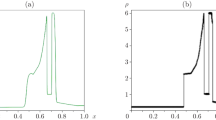Abstract
An analysis is made of the possibility of building divergence free elements for the approximation of the Navier-Stokes equations of an incomprensible fluid. Two types of appoximation are considered. In the first real divergence free elements are considered. Many examples are given and error bounds are derived. It is shown that 0 (h 4) precision can be obtained using fourth degree polynomials. In the second type of approximation the incompressibility condition is satisfied only in the average. Two and three dimensional examples are given, using respectively second and third order polynomials.
A possible numerical scheme is proposed for the case the steady-state linearized Stokes problem. Experimental evidence shows that it can be also used in the general non-linear case. Simple numerical results are presented for the cavity problem in two dimensions.
Similar content being viewed by others
Bibliographie
Aubin J. P.,Approximation des espaces de distributions et des opérateurs différentiels, (1966), Thèse, Paris.
Bensoussan A., Lions J. L., Temam R.,Décomposition des problèmes d'optimisation (1972), Cahiers de l'IRIA.
Birkhoff G., Schultz M. H., Varga R. S.,Piecewise Hermite Interpolation in one and two Variables with Application to Partial Differential Equations, Numerische Math.11 (1968), 232–256.
Cea J.,Approximation variationnelle des problèmes aux limites, Ann. Inst. Fourier14 (1964), 345–444.
Ciarlet P. G., Raviart P. A.,General Lagrange and Hermite Interpolation in R n with applications to Finite Elements Methods, à paître. Arc. Rat. Mech. and Analysis (no 3)46 (1972) 177–199.
Ciarlet P. G., Wagschal C.,Multipoint Taylor Formulas and Applications to the Finite Element Method, Numerische Math.17 (1971), 84–100.
De Rham G.,Variétés différentiables (1955), Hermann Paris.
Ergatoudis I., Irons M., Zienkiewicz O. C.,Curved Isoparametric Quadrilateral Elements for Finite Element Analysis, Int. J. Solids Structures4 (1968), 31–41.
Felippa C. A., Clough R. W.,The Finite Element Method in Solid Mechanics. Proc. Symp. AMS and SIAM, Durham N. C., April 5–6, 1968, Birkhoff G. and Varga G., Editors, pp. 210–252, SIAM-AMS, Proc. vol. II, American Mathematical Society, Providence R. I. (1970).
Fortin M.,Approximation d'un opérateur de projection et application à un schéma de résolution numerique des équations de Navier-Stokes (1970), Thèse de 3e cycle. Paris Orsay.
Fortin M., Peyret R., Temam R. Résolution numérique des équations de Navier-Stokes pour un fluide visqueux incompressible, Journal de Mécanique10 (1971), 357–390.
Fraeijs De Veubeke B.,A Conforming Finite Element for Plate Bending, Int. J. Solids Structures4 (1968), 95–108.
Lions J. L.,Contrôle Optimal de systèmes gouvernés par des équations aux dérivées aux dérivées partielles (1968), Dunod Paris.
Lions J. L.,Quelques mèthodes de résolution des problèmes aux limites non linéaires (1969), Dunod, Paris.
Magnes E., Stampacchia G.,I problemi al contorno per le equazioni differenziali di tipo elliptico, Ann. Sc. Norm. Sup. Pisa12 (1958), 247–357.
Raviart P. A.,Sur l'approximation de certaines équations d'évolution linéaires et non linéaires, J. Math. Pures App.46 (1967), 11–107, 109–183.
Sander G.,Bornes supérieures et inférieures dans l'anayse matricielle des plaques en flexion torsion, Bull. Soc. Sci. Liège33 (1964), 456–494.
Srang G., Fix G.,An analysis of the Finite Element Method, à paraître.
Temam R.,Une méthode d'approximation de la solution des équations de Navier-Stokes, Bull. de la Soc. Math. de France96 (1968), 115–152.
Thomasset,Thèse de 3e cycle (1973), Université de Paris-sud.
Zenisek A.,Interpolation Polynomials on the Triangle, Numerische Math.15 (1970), 238–296.
Zlamal M.,On the Finite Element Method, Numerische Math.12 (1968), 394–409.
Zlamal M.,A Finite Element Procedure of the Second Order of Accuracy, Numerische Math.14 (1970), 394–402.
Begis D.,Analyse numérique de l'écoulement d'un fluide de Bingham (1972), Thèse de 3e cycle, Université de Paris-Sud.
Ciarlet P. G., Raviart P. A.,Interpolation Theory over curved elements with applications to the finite element method. Computer Methods in Applied Mechanics and Engineerin1 (1972), 217–149.
Hirsch J. E.,The finite element method applied to ocean circulation problems (à paraître).
Lascaux P.,Applications de la méthode des éléments finis en hydrodynamique bilimensionnelle, utilisant les variables de Lagrange. Rapport technique C. E. A. Limeil 1972.
Norrie D. H. De Vries G.,Application of the finite element method in fluid dynamics. Von Karnann Institute for Fluid Dynamics, Lectures Series 34.
Oden J. T.,A Finite Element Analogue of the Navier-Stokes Equations. Journal of the Engineering Mechanics Division, ASCE no EM 496 (1970).
Author information
Authors and Affiliations
Additional information
Ce travail a été rendu possible en partie grâce à une subvention du Conseil National de la Recherche du Canada.
Rights and permissions
About this article
Cite this article
Fortin, M. Utilisation de la méthode des éléments finis en mécanique des fluides, I. Calcolo 12, 405–441 (1975). https://doi.org/10.1007/BF02575757
Received:
Issue Date:
DOI: https://doi.org/10.1007/BF02575757




